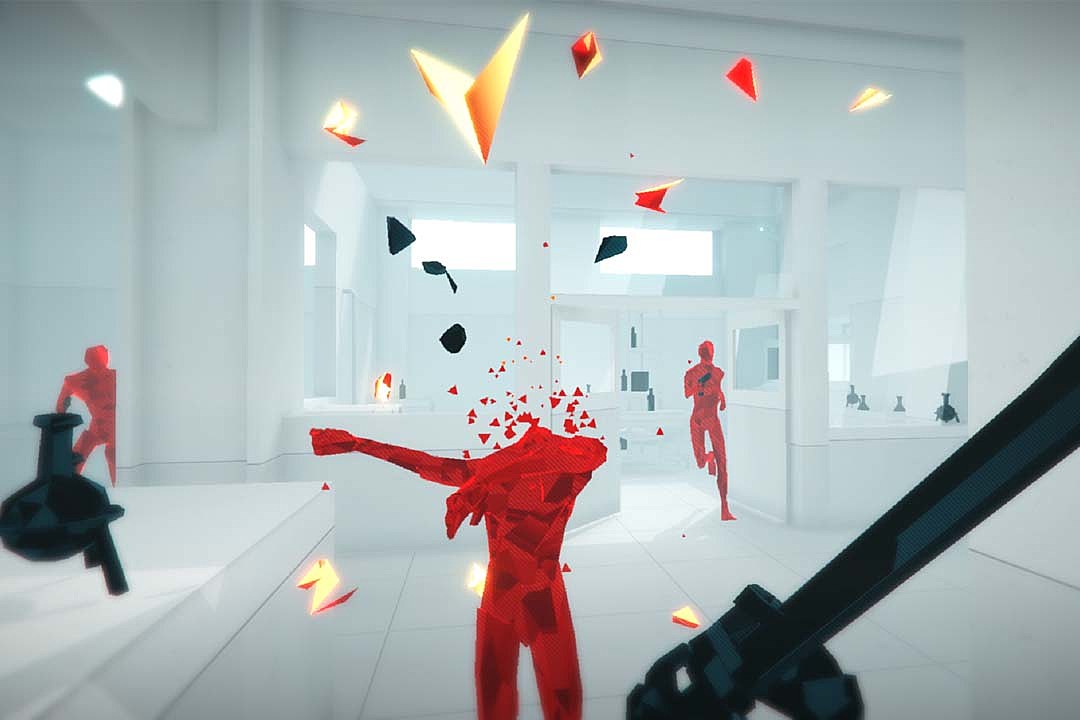

The responses have been predetermined, yet the story alludes to how much control you really have. To converse with your anonymous chatroom friend, you input the keystrokes yourself, too. Text rolls over to the next line mid-word, colors bleed toward the edges of the emulated CRT monitor, and the deafening clacks of an aged keyboard trigger nostalgia for the computers that seeded my gaming passion. The developers also bundle Superhot in a fake DOS interface that sealed the grin on my face. As I said, Superhot channels The Matrix, minus the excessive Keanu. I altered the final cut as if the character acquired teleportation, closing gaps between victims before they could blink. During a particularly daring run through a museum, I split two dummies in half via katana, killed again when I flung the blade at a distant third, then executed the fourth and fifth after using a thrown ceramic dog to intercept their bullets. The best part is that you can save and edit your jaw-dropping tricks with a built-in replay editor. Can you snatch that bat before an incoming jab connects? One hit and it’s lights out for you. Guards lunge for guns within reach, firearms possess finite ammo, and grabbing items fast-forwards the clock by a few seconds. Threats prove constant, but the best hitmen approach each brawl as if it were a puzzle, recalling Superhot’s quirks. Time progresses, though glacial in pace, when you’re inert. “Time only moves when you move.” False … somewhat. Superhot’s tutorial musings will mislead newcomers, then. Superhot expects its fans to think on their feet, always lending players sufficient tools to orchestrate their survival. I translated the skills I’d picked up in less forgiving fights into a cinematic blend of broken glass, savage punches, and precise gunshots. As luck would have it, I became a better player for it.
#Superhot reviews update#
Before launch, a surprise update reset my progress, requiring a full restart to see stages I had not yet finished. Superhot understands immersion, always striking a superior balance of gameplay and story, never permitting one to fall to the wayside long enough that you get bored with the other.īack in the real world, I was issued a debug copy of Superhot at first, one that allowed me to unlock all the content via in-game commands. Their intentions remain purposely vague, but if you heed the group’s advice to quit the game itself, you cannot continue until you revisit the previous level. Rather, the program professes the basics of combat, like stunning opponents to strip their guns, or that time primarily moves when you do.Īnd then another party intervenes, forcibly cutting your session short. Infiltrating a developer’s server allows hackers to butcher faceless bad guys, and a couple venues contain connective tissue. Although an apparent friend emails you a file called “superhot.exe,” little is right with the executable. And yet I only feel safe in divulging Superhot’s setup. When I was ordered not to continue, I declined. I committed acts that made me second guess every action. Superhot basks in the abstract, and spoiling the plot would defile your involvement as the character. “I didn’t get it at first, either,” a nameless friend declares. Every level ‒ such as alleys, a train station, or parking garage ‒ looks more pristine than an asylum, and your faceless assailants shatter into polygons when you exhaust their usefulness. I also recommend Superhot without hesitation, but selling somebody on the narrative is a tough task when it strays into meta-territory so cleverly. What happens when a game does not want to be played? Calendula prompts viewers to scour the settings and other menus, analyzing each screen for codes or clues that justify the haunting imagery. Pony Island feigns the role of an innocent equine platformer to rob players of their souls, but correcting the program’s in-game glitches will procure your escape. Superhot chases the recent game-within-a-game trend, too. Superhot also adopts a light hacker motif, and the results brew an energetic, first-person thriller full of watercooler moments from the first level to the last.

While Superhot leverages those set pieces as inspiration, its developers layer enough material around that bullet-time framework to keep the gameplay fresh. From the lobby shootout to Neo’s enviable limbo maneuvers, innumerable directors and developers have since parodied both scenes. Superhot invokes the most iconic parts of The Matrix, namely the slow motion.


 0 kommentar(er)
0 kommentar(er)
